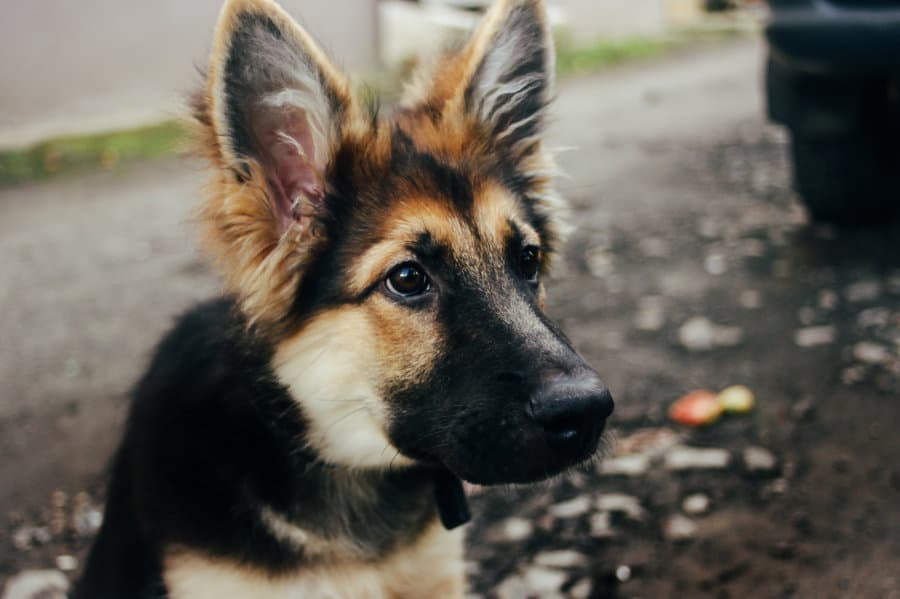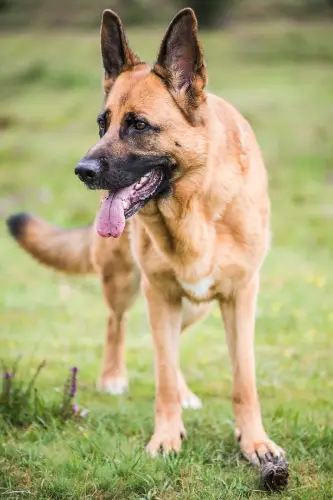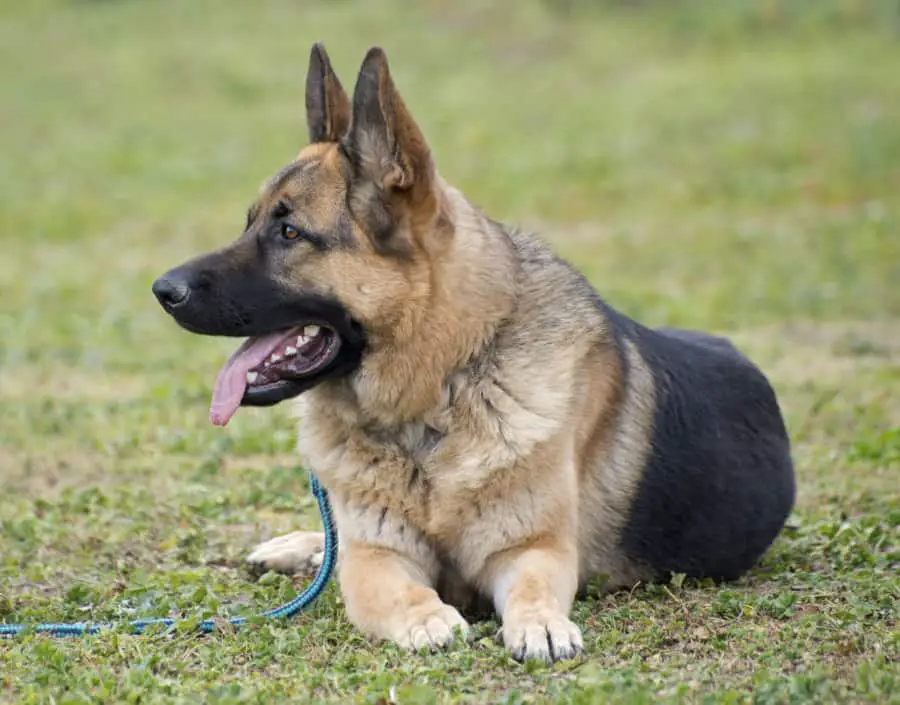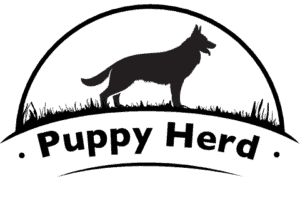German Shepherds are loyal and fierce dogs that can be an excellent addition to any family. With their iconic look, you can spot a German Shepherd from a great distance. Even when they are a mixed breed with another dog, their features shine through, and that includes their ability to shed profusely.
Shedding is a common issue with German Shepherds, simply because of the type of coat they have. Unlike other dog breeds, they shed continuously year-round, which can be a hassle if not adequately dealt with.
The good news is this shedding can be dealt with as long as you keep a few tips in mind. Below, we’ve compiled a complete guide to German Shepherds, their coats, and different ways to try and deal with their shedding.

Understanding German Shepherd Coat Anatomy
German Shepherds will shed; there is no way around it. It is why they have earned the nickname “the German Shedders.”
Most German Shepherds have two different coats: a top coat that sheds the entire year and an undercoat that “blows” twice a year. The top coat is the coat you touch and pet the most, which has a stiff, bristly feel to it. The undercoat is made of a thick, dense fur that is much softer than the top coat.
Top Coats & Shedding Frequency
The top coat of a German Shepherd is the coat that you see and feel the most. The hairs are finer here than the undercoat and can also be a different color.
This coat is a protective layer that traps a lot of dirt and debris to protect the skin from any insects or parasites. Brushing a German Shepherd will usually involve the top coat first, as it is the most prone to shedding all over the place.
For the most part, the top coat sheds on its own naturally. Unlike the undercoat that blows twice a year, the top coat sheds daily. Also, depending on the season, the top coat can shed more or less.
Undercoats & Shedding Frequency
Twice a year, the German Shepherd will “blow” their undercoat: this means the coat will come off the dog in large chunks of fur. This happens over a couple of days or a week and is completely natural. (Source)
The amount of fur that can come off a German Shepherd during these periods typically equals the dog’s size. (This can come as a surprise to those who are not familiar with how much German Shepherds shed!)
If you are concerned you will have to deal with this shedding experience for the German Shepherd’s entire lifespan, know that there is a little relief to be had when the dog is still a puppy.
Shedding For Adult Dogs Vs. Puppies
German Shepherds are great companion dogs and ones that are loyal, sometimes to a fault. To care for German Shepherds, though, you will have to be prepared for their shedding as early as the puppy years. Below are a few coat differences to keep in mind for different ages:
Adult German Shepherd Coats
As previously mentioned, along with normal shedding, German Shepherds also go through a “blowing” season where they lose their undercoat fur. This happens twice a year, usually around the change in seasons from warm to cold and vice versa. This shedding is completely natural and necessary for the German Shepherd.
It can take a good amount of time for the blowing seasons to complete their cycle, anywhere from 10 days to a couple of weeks. The amount of fur that comes off the dog can be a lot; it generally amounts to the size of the dog itself.
The owner can help their German Shepherds during these heavy shedding seasons by brushing the undercoat daily; this prevents the fur from getting tangled and matted.
Preparation for these times of the year is critical. Be on the lookout during the changing of the seasons to see if chunks of fur start to come off your dog. Once you see the fur coming off, do not attempt to speed up the process by pulling off the hair.
Using a brush specifically designed for their undercoat is the best way to help. The fur is usually dead, and it comes off this way without harming the skin.
German Shepherd Puppy Coats
German Shepherds puppies are born a giant fluff ball. Their coats are large and full to protect the vulnerable puppy from outside dangers and to keep them warm as they grow up.
German Shepherds will reach their full size at around 12-24 months old, depending on each dog, but their maximum growth will not be completed until about three years old. That means you won’t have to deal with too much fur until they approach closer to two or three years in age. (Naturally, the larger the coat, the more that will shed.)
Though German Shepherds are not fully grown until around the two-year mark, they will lose their puppy fur well before that. For younger German Shepherds, this losing of the fur occurs around the four-to-six month range.
The shedding process for puppies happens similarly to the undercoat blowing of a full-grown adult. It takes anywhere from 10 days to two weeks for their fur to shed entirely. Unlike the blowing of adults, though, the puppy fur can come off in larger chunks, and it may happen in stages.
As the German Shepherd grows, the amount of hair that the young pup will shed will increase.
Like with adult German Shepherds, brushing a puppy’s coat can help reduce the amount of hair that comes off on its own. If you can brush their fur two to three times a week, that can significantly reduce the amount of fur left behind.
Shedding Differences Across German Shepherd Species
It’s worth mentioning that particular species or mixed breed German Shepherds may have slightly different coats compared to their purebred counterparts.
For example, certain species of German Shepherds do not have an undercoat or have a thinner one. These Shepherds are typically referred to as “long-haired” German Shepherds, but some breeders do not consider these dogs to be purebred.
Another difference in coats you’ll notice across different German Shepherd breeds is whether they are hypoallergenic and the frequency of their shedding.
Any dog that traditionally sheds, like the German Shepherd, is considered non-hypoallergenic. This is because their fur is likely to carry allergens that can spread throughout the home once their hair begins to blow.
However, those who enjoy the attributes of the German Shepherd but don’t want to suffer from allergies (or excessive shedding) may prefer a breed of German Shepherd that is mixed with a hypoallergenic dog. A German Shepherd that is hypoallergenic is less likely to shed compared to its non-hypoallergenic, purebred counterparts. (Read more about Hypoallergenic German Shepherds)

An example of such a mixed breed is the Shepoodle, which is a mix between a German Shepherd and a Poodle; the Shepoodle’s fur more closely resembles a Poodle’s. However, while the hair does not shed, the coat will still need to be maintained almost daily to avoid knots and matted fur.
Other examples of mixed-breed German Shepherds that are hypoallergenic are:
- Sheptese (German Shepherd and Maltese)
- German Yorkie Shepherd (German Shepherd and Yorkie)
- Giant Schnauzer (German Shepherd and Schnauzer)
So, if you want a German Shepherd that doesn’t shed as often, consider adopting a mixed-breed that has at least one hypoallergenic parent.
Why Do German Shepherds Shed?
German Shepherds are well known for their shedding, but there is more than one reason why they do it so much:
- For one, their coats are protective layers for their skin, so having the healthiest fur possible for protection is essential. The fur that they shed is mostly just dead fur.
- The changing of the seasons is another reason German Shepherds will shed. To keep warm in the winter, the dogs will shed less to keep a protective, warm layer over their skin. But when the seasons change to a hotter season, they will shed to avoid overheating.
- Another reason that German Shepherds will shed is that they are not fed properly. A well-balanced diet is essential not only for the health inside the dog’s body but also for their coat. Fatty acids and proteins are necessary for a German Shepherd’s diet to maintain a healthy and full fur coat. A surefire giveaway of an unhealthy diet is excessive shedding and spotty coats.
- Allergies plague all dogs, including German Shepherds. They might be allergic to something in the air, their food, or something else, but any allergy can have an adverse reaction in their shedding amounts and the appearance of their fur. Along with that, excessive scratching can lead to bald spots in the dog’s fur, which can be a sign of an allergy.
- An illness can also be the cause of excessive shedding for a German Shepherd. If the dog is sick, they may not be getting enough positive nutrients to their skin, which produces healthy fur. Excessive shedding might occur because there is just unhealthy hair growing in place of dead fur or not being replaced by healthy hair.
- Other things like sunburn and parasites also can contribute to the excessive shedding of German Shepherds. Dogs can get sunburnt on their skin, inflaming the area, which induces excess shedding. Also, parasites can cause irritable skin, leading to excessive scratching and more shedding.
- Finally, hormonal changes and an increase in stress can both also cause excess shedding. If a German Shepherd feels more pressure than usual, they are prone to shed more than average. For their hormonal changes, it can range from pregnancy to being neutered/sprayed. These can all affect the skin and how healthy it is, which can induce more shedding.

How To Reduce Shedding In German Shepherds
There are several ways you can help reduce the amount of fur your German Shepherd sheds, including brushing and bathing them regularly and feeding them a healthy, balanced diet.
Brushing A German Shepherd
Brushing your German Shepherd can be vital for several different reasons that go beyond reducing shedding.
- If not properly brushed, the German Shepherd’s top coat can get knots and tangled fur, which can lead to damaged fur and skin. Brushing the coat can get rid of free hairs and knots so that new, healthy hair can regrow in place.
- Brushing can help remove dirt and prevent more from building up in the coat to maintain the coats’ health. The removal of dirt can also help prevent diseases from coming to your German Shepherd.
- Another reason to brush your German Shepherd is to help improve the health of their skin. Brushing can feel like a massage for the dog and increases blood circulation in the skin. This can promote and increase the growth of healthy hairs. Along with that, it also helps the skin of the German Shepherd to breathe properly with fewer buildups and blockages.
- A final reason to brush your German Shepherd is to improve the bond with your dog. Brushing forms a relationship with your dog as they realize you care for them as much as they care for you. Remember, German Shepherds are very loyal dogs, so brushing them is a way you can reciprocate that loyalty.
Tips For Brushing German Shepherds
When it comes to brushing your German Shepherd, be sure to have the dog recognize that it is time to be brushed and not playtime. Having the dog calm and standing still can make both the process of brushing and cleanup that much easier if it is done in one location.
- First, brush their fur in the direction that the hair is growing. This allows for looser hairs to come off easily with the brushing motion. The motion also allows for more dead hair to be removed. Brushing against the grain can pull both healthy and dead hairs.
- Be patient with the brushing. It will take multiple brushing strokes to complete the task, so not rushing and not trying to brush too harshly is key. If you go too hard, your dog may not like the feeling and it could lead to bruises. (Source)
Bathing A German Shepherd’s Coat For Shedding
Bathing a German Shepherd is not like bathing a child: you do not have to do it every day.
The ideal amount of bathing for German Shepherds is once a month at most, although some recommend bathing them every 4-5 months if they do not go outside often. Bathing is key for the health of your dog’s coat as well as how they shed. (Source)
The reason to bathe your German Shepherd is, first and foremost, to maintain the dog’s cleanliness. Bathing your dog can be beneficial for the dog’s fur as cleaning can get rid of any unwanted dirt and loose hair. A bath can also promote healthy skin and shedding.
Tips For Bathing
Bathing can be an adventurous time for you and your dog if your dog is not used to baths. The best way to find out if your German Shepherd is okay with baths is to see how they react to being wet. Once you know how well your dog reacts to being wet, slowly progressing them to being bathed is the best plan.
Like bathing a child, preparation is key. Having multiple towels, a sponge (if you want), dog shampoo, and either the bathtub or large container is what you will need. Be sure you are using a dog shampoo rather than a human shampoo as the dog shampoo is better for their fur.
When bathing, massage deep into the coat to ensure that your dog is clean of any dirt and debris that might otherwise harm them. This process will also help remove lingering fur that has not fallen off from shedding.
Diets That Help Reduce Shedding
Feeding your German Shepherd the correct diet can help maintain a healthy coat and reduce shedding and matting.
A meat-based diet with special additives to ensure healthy fur and skin is what you are looking for. Avoid inexpensive dog foods that are heavily corn-based, as many dogs have trouble digesting it.
Also, maintain the hydration levels of your German Shepherd by keeping fresh water in their bowls. This will prevent their skin from becoming dry, and reduce shedding. (Source)

Products To Combat German Shepherd Shedding
Like with most breeds of dogs, specific products can be found that will be generally used for German Shepherds.
Brushes To Help With Shedding
There are so many varieties of brushes for dogs that finding one can be a nightmare. Luckily, for German Shepherd owners, there are two distinct variations of brushes that you will need: one for the top coat and one for the undercoat.
- The top coat brush will be a “slicker” brush that helps maintain the fur on the coat itself. The slicker brush does not mean it will not take hairs away; it just means it will not go as deep into the coat. With shorter, gentler bristles, the brush simply ensures the coat’s health is up to par.
- The undercoat brush is more of a rake or de-shedding brush. This brush is more heavy-duty with broader, more spaced out bristles that can brush through a wider range of fur. This brush is intended to go deep into the hair to get any entanglements and clumps of fur out. This will help clear up knots that can cause issues for the German Shepherd.
Here are a few examples of brushes worth looking into for your German Shepherd:
- Furminator Deshedding Dog Brush – This brush is ideal for brushing the undercoat of your dog. It picks up a lot of the dead and loose fur from the undercoat, and it has a release button to remove the hair from the brush.
- PETDOM Self Cleaning Slicker Brush – This brush is ideal for the top coat of your German Shepherd. With shorter bristles, it can glide through the shorter hair on top without nicking the skin.
- The Pet Neat Brush – This might be the best two-for-one brush on the market. It has bristles close enough to deal with the top coat, but long enough to help with the bottom coat. Built for convenience, this brush is the go-to for those wanting to reduce the number of brushes in their pet bin.
Shampoos To Reduce Shedding
There are a few ingredients to look for in dog shampoos that help coat health; these include rosemary, aloe vera, and lemongrass. All are beneficial to the health of your dog’s skin and coat.
There are also various shampoos that are specifically meant for puppies and some that are meant for adult dogs. Be sure to check each label and see which age range the shampoo is intended for, as mixing them up can potentially harm the health of your German Shepherd’s fur.
Along with that, there are specific brands that include ingredients in their formulas that help reduce the amount of dander and help moisturize the skin, which means less shedding.
Here’s a list of organic, natural, and overall great shampoos that work for puppies and adult German Shepherds:
- 4-Legger Certified Organic Dog Shampoo – This shampoo boasts ingredients like lemongrass and aloe vera that help with the health of your dog’s fur. These ingredients also help reduce shedding!
- Paws and Pals Oatmeal Shampoo – This shampoo is made for dogs with sensitive or irritable skin issues. It helps moisturize the skin to promote healthy fur growth, which also helps with the problem of shedding.
- Arava Dog and Puppy Shampoo – This is the best shampoo if your dog likes to get out and into the woods or fields to play because it provides defense against over 500 different types of insects, fleas, and ticks.
This is just a small list of the different variations of the shampoos available. However, if you’re still not sure which shampoo will work best for your pup, it’s always a good idea to consult the veterinarian for recommendations.
Clean Up Fur With A Vacuum
Vacuums may be the most essential item to buy if you are going to raise a German Shepherd. The reason for the nickname, the German Shedder, is because these dogs will shed everywhere and all the time. With that said, a vacuum will be a necessity.
You will want a vacuum that can pick up lots of large clumps of hair with ease without getting clogged quickly. However, finding the right vacuum that can do this can be a challenge.
Finding The Right Vacuum
First, you will want to assess what type of flooring you have in your house to find the vacuum that will work the best. For example, hardwood floors require a different kind of vacuum than carpets. Any specific attachments that can come in handy to clean up fur in tight corners or underneath furniture are also things to look out for.
- For hardwood floors, be sure to find a vacuum that will not damage the floor while still powerful enough to get all the loose hair left behind by your German Shepherd. A lot of these vacuums will be made with rubber bristles as to not damage the flooring while still providing ample suction.
- For carpet floors, vacuums are more likely going to have bristles that can attract dirt, debris, and hair to the vacuum to be sucked up. You will want a powerful enough vacuum to suck the hair from deep in the carpet, but not too powerful that it will damage the rug at the same time.
Some vacuums are specifically used and built to deal with pet hair removal. These vacuums have attachments like bristle-headed brushes and extension hoses to allow for better reach and a more ample sucking power.
German Shepherds Will Always Shed
German Shepherds are great dogs that began as work dogs, but now have become great family pets. They are loyal to their owners, protective of the young and frail, and have bounding energy levels. While these are all positive attributes, there is a reason they have the nickname “German Shedders.”
German Shepherds will shed no matter what you try to do about it; there is no stopping it. But the best owners are the ones who try and reduce the amount they shed in a variety of ways.
First, they understand that shedding and blowing happens, so do not try to undermine it. The process is natural and necessary for the health of the German Shepherd.
Brush your German Shepherd at least two to three times a week, if not more. These brushing sessions help reduce the amount of hair that is shed naturally, plus it keeps the dog’s coats healthy, and it can be a bonding experience between pet and owner. Bathe your German Shepherd only once a month, and feed them a balanced, nutritional diet to keep their coat and skin healthy.
Overall, German Shepherds are great dogs and can be taken care of easily as long as you’re prepared for how much they can shed.
